Abilis CPX 2000, update 6.3.0
Released on March 2, 2009.
Enhancements
-
Added support for various new hardware. For a general description of it please read the 6.3.0 release news.
-
Added support for BRI1 card.
This card has not been released yet. It is intended to be included in future micro-Abilis only.
-
Added support for MFLPC.
This is a new flavour of MFIDE and will be used in the future micro-Abilis.
-
Added support for QPRIX and PB44X cards.
These card are configured in the same way as the former QPRI and PB44, and they can replace former QPRI1, QPRI2, PB44 without any need to change the configuration.
There are QPRIX options that hosts an Extended Echo Canceller for 64 unidirectional channels (32 bidirectional) that can cancel echo up to 128 msec. The use of the EEC is configurable on a per-routing base via the parameter
EEC:, whose values can beNO,IN,OUT,BOTH.-
NO -
The EEC is not used. If the call uses an AC, the default 40 msec EC is used.
-
IN -
The EEC in inserted on the in side of the call. For VtoX calls you need to specify IN.
-
OUT -
The EEC in inserted on the out side of the call. For XtoV calls you need to specify OUT.
-
BID -
The EEC uses a bidirectional echo canceller and cancels echo on both sides of the call. It's useless for VtoX or XtoV calls, it may be required in TR calls in certain specific cases.
When the EEC is enabled, the default EC of the AC is disabled. This is to prevent quality degradation when two echo cancellers are put in series.
If you enable EEC for a side that does not need EEC, the EEC will not be enabled, for example if you configure OUT in VtoX and IN for XtoV.
The actual use of EEC is visible in the D CTICE output.
The CTISYS has two parameters for the EEC,
AEC:(NO or YES) andTAIL-BASE:(0...896 msec)-
AEC -
Acoustic Echo Canceller. When set to YES is enables for ALL the EEC channels the capability to cancel acoustic echo too. In normal telecom applications the AEC is not needed, but we wanted to offer this option at least for testing purposes. If there will be an actual need we can introduce a per-routing parameter.
-
TAIL-BASE -
The EEC can cancel echo in the range 0..128 msec. By specifying here a value greater than 0 you shift ahead the range. For example if you set
TAIL-BASE:256, the EEC is able to cancel echo between 256 and 384 msec.
-
-
Added support for RJ45 Switch.
The device switches pins 3-4-5-6 of the RJ45 ports. The connector LINEx is connected to either connector MAINx or BACKUPx via relays contacts.
Via appropriate adaptation cables it is possible to switch the following type of lines:
-
Any telco line as POTS, ADSL, HDSL, SHDSL ...
-
ISDN BRI and PRI interfaces
-
Ethernet 10 and 100 Mbit/sec
-
USB 1.1 and 2.0 up to 480 Mbit/sec.
To enable it you must add resource RJS-x, where x is the number of the resource. You may attach and enable as many RJS devices as you need.
The lines can be configured independently via
L1:toL8:parameters:-
AUTO -
This is the normal way. The line is switched to BACKUP when the RJ45 box is not driven (e.g. Abilis powered off), and switched to MAIN when the RJ45 box is driven.
-
MAIN -
Line is forced to MAIN as soon as the RJS is powered on, and will stay MAIN.
-
BACKUP -
Line is forced to BACKUP as soon as the RJS is powered on, and will stay BACKUP.
The state of the lines can be temporary forced using the S S RES:RJS-x Lx:AUTO | MAIN | BACKUP | DEFAULT command.
There are two important parameters:
-
LIVE-EXPIRY -
How much time the live signals from the Abilis CPX must be absent prior to switch to BACKUP. The default value of 120 seconds is intentionally large to avoid problematic flapping of the lines.
-
REBOOT-PROTECTION -
When you reboot the Abilis CPX, the live signal will disappear for the period needed to have the Abilis functional again. In some cases this may take longer that
LIVE-EXPIRY.When
REBOOT-PROTECTION:YESand you issue WARM START or RESTART SYSTEM, a special signal is sent to RJ45 switch that temporary increase the LIVE-EXPIRY to 10 minutes. In this way the lines are not switched during a normal system reboot.
Note that if the RJ45 switch is POWERED OFF all the lines are switched to BACKUP.
-
-
Added support for GPS receiver.
The device has to be connected to a USB port of the Abilis, and to activate it you must add resource GPS-x, where x is the number of the resource. You may attach and enable as many GPS devices as you need.
It currently supports a simplified logging by writing the position into a file at predefined intervals with comma separated values format, a format that can be uploaded to various sites to view the path on a map. Beware that the file can grow indefinitely, so it's up to you to retrieve and delete the file. Future versions will probably offer a more sophisticated logging. The file(s) are saved in the WDIR path (default C:\APP\GPS) and they are named Gps-x.log, where x is the number of the resource.
The D D command show you the current values, example:
[16:57:16] CPX_208:d d gps RES:Gps-1 --------------------------------------------------------------------- STATE:UP USB-STATE:CONNECTED -------------------------- DATE (UTC)| 2009-02-26 TIME (UTC)| 15:57:19.055 LONGITUDE | E 10:47.5918 LATITUDE | N 45:11.6045 ALTITUDE | 30.89 m SPEED | 0.00 km/h COURSE | N/A SATELLITES| 5 -------------------------- - Satellites ----------------------------------------------------------- ID | Used | Azimuth (deg) | Elevation (deg) | SNR (db) ----+------+---------------+-----------------+----------- 2 | NO | 300 | 35 | 0 4 | YES | 241 | 54 | 43 7 | YES | 170 | 49 | 39 8 | YES | 192 | 15 | 42 13 | NO | 21 | 75 | 16 16 | NO | 55 | 11 | 19 20 | YES | 116 | 24 | 25 23 | NO | 57 | 46 | 28 25 | YES | 138 | 66 | 38 32 | NO | 112 | 2 | 0 [16:57:19] CPX_208: -
Added a SYSLOG driver, referred in Abilis CPX as Syslog resource, that may act as syslog client as well as syslog relay.
It is possible to specify up to 4 syslog server as recipients of the events.
In this version only SYSTEM LOG events are sent to SYSLOG.
-
Added a new service called Operator Panel Control (OPC), which is enabled by activating the HTTP and the OPC resource.
This service uses HTTP and a client browser with Javascript enabled to show the CTI state of users and their calls. Each user may have assigned up to four interfaces: a CTIP (a.g a POTS port or an ISDN or a GSM/UMTS port), a CTI CLUSTER, SIP and IAX.
The OPC resource may connect to remote Abilis CPX in the same way as a client browser does, retrieve the users/calls state of that Abilis and merge the information with those of the local Abilis CPX. In this way an operator may see on his panel the users/calls state of many Abilis CPX. A local identifier is assigned to each of the remote Abilis.
Some screenshot of what is visible in the browser:
Figure: OPC Panel view, with details window opened
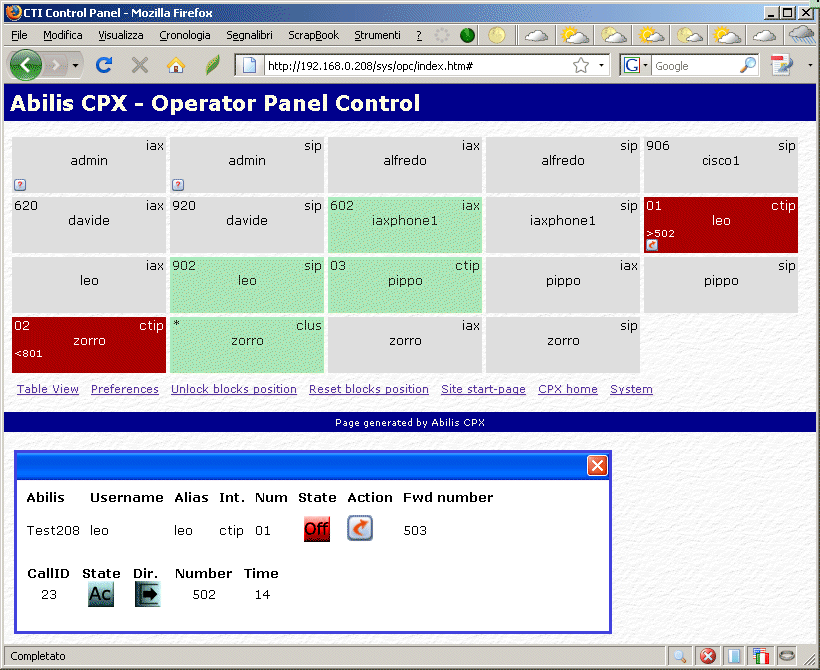
Figure: OPC table view
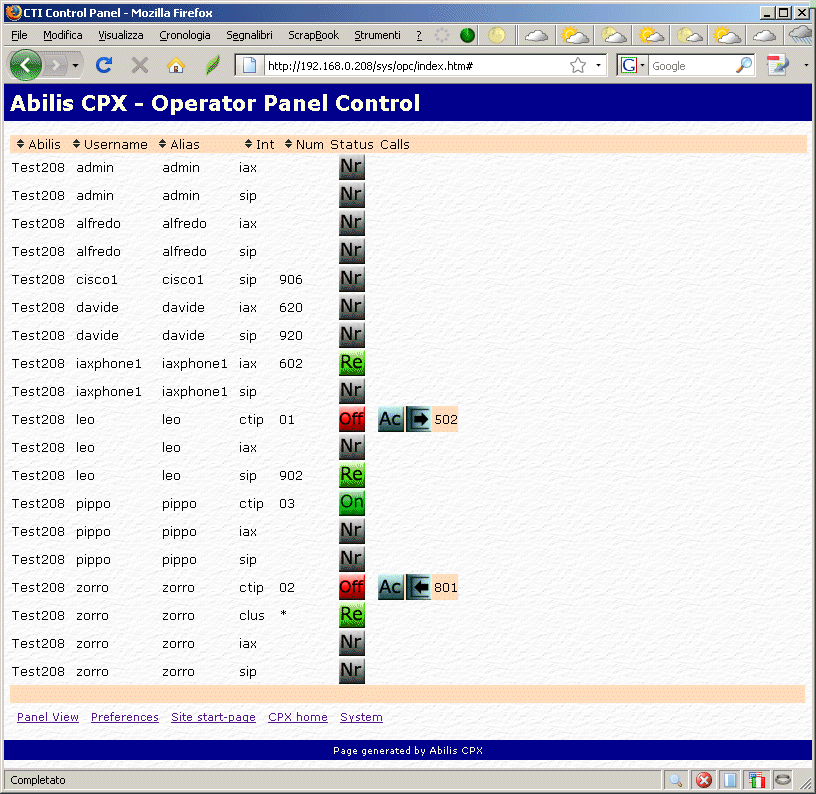
Figure: OPC preferences window

Each Abilis user can be included or excluded in the monitoring by means of the
OPC-MONITOR:parameter which is present in the user parameters, and by default monitoring is disabled. It is also possible to choose which interface type of the user will be visible in the monitor.In case that the local OPC must collect events from one or more remote OPC, it is necessary to configure them in the OPC resource.
Here are the steps to activate OPC and HTTP:
[19:50:36] ABILIS_CPX:a res:opc COMMAND EXECUTED [19:50:41] ABILIS_CPX:s p opc act:yes abilisid:myabilis COMMAND EXECUTED [19:50:50] ABILIS_CPX:a res:http RES:HTTP ALREADY EXISTS [19:50:54] ABILIS_CPX:s act res:http COMMAND EXECUTED [19:51:25] ABILIS_CPX:s p http act:yes act-p:yes COMMAND EXECUTED [19:53:47] ABILIS_CPX:save conf VALIDATION IN PROGRESS ... WARNING: RES:Tcp Changed "SESNUM" from 6 to 18 VALIDATION SUCCESSFULLY EXECUTED SAVE EXECUTED [19:53:49] ABILIS_CPX:d p opc RES:Opc ----------------------------------------------------------------------- DESCR:Operator_Panel_Collector LOG:NO ACT:YES XML-TOUT:60 maxusers:200 maxcalls:200 maxclients:20 maxremotes:0 abilisid:myabilis [19:53:55] ABILIS_CPX:d p http RES:Http ---------------------------------------------------------------------- DESCR:HyperText_Transfer_Protocol LOG:NO ACT:YES LOGIN-COOKIE-TOUT:1440 WDIR:C:\APP\HTTP\ START-PAGE:SYS (/sys/pub/cpx.htm) SYS-CSS:SYS (/sys/pub/cpx.css) - HTTP plain ----------------------------------------------------------- ACT-P:YES tcp-locport-p:80 sesnum-p:12 IPSRC-P:* IPSRCLIST-P:# - HTTP ssl ------------------------------------------------------------- ACT-S:NO tcp-locport-s:443 sesnum-s:0 IPSRC-S:* IPSRCLIST-S:# [19:53:57] ABILIS_CPX:warm startThe OPC page is available under /sys/opc, thus by default it is available to user admin only. A good practice is to define the HTTP rights for the OPC service and add the desired users. Assuming that
user1anduser2are already created and are enabled to HTTP service, and they are those allowed to monitor the calls, the procedure is:[19:57:23] ABILIS_CPX:a http rights path:/sys/opc/ user:user1 COMMAND EXECUTED [19:57:41] ABILIS_CPX:a http rights path:/sys/opc/ user:user2 COMMAND EXECUTED [19:57:43] ABILIS_CPX:d http rights - Not Saved (SAVE CONF) ------------------------------------------------------- ------------------------------------------------------------------------------- ID: PATH: USER: FILE: DIR: RECUR: PROT: ------------------------------------------------------------------------------- 1 /sys/ admin r--- l--- YES PLAIN,SSL ------------------------------------------------------------------------------- 3 /sys/opc/ user1 r--- l--- YES PLAIN,SSL user2 r--- l--- YES PLAIN,SSL ------------------------------------------------------------------------------- 2 /sys/pub/ anonymous r--- ---- YES PLAIN,SSL ------------------------------------------------------------------------------- [19:57:48] ABILIS_CPX:save confNow it is necessary to enable monitoring for the users that must be monitored, and if necessary assign to them a CTIP or a CLUSTER. The assignment is not required for the SIP and IAX interface because the user is already a SIP/IAX user!
In the following example, user Alice have just a CTIP, user Joe has a CTIP and a SIP account, while the user boss has a CTIP, a CLUSTER, a SIP account and a IAX account, and we want to monitor all of them:
[20:03:35] ABILIS_CPX:s user:alice ctip:101 opc-monitor:ctip COMMAND EXECUTED [20:03:50] ABILIS_CPX:s user:joe ctip:102 opc-monitor:ctip,sip COMMAND EXECUTED [20:07:14] ABILIS_CPX:s user:boss ctip:103 clus:clus1 opc-monitor:all COMMAND EXECUTED [20:08:07] ABILIS_CPX:d user - Not Saved (SAVE CONF) ------------------------------------------------------- USER: PWD: ACT: CTIP: CLUS: PPP: FTP: HTTP: MAIL: IAX: SIP: --------------------------------+--------------+------------------------------- admin NO # # YES YES YES NO NO NO alice YES 101 # NO NO NO NO NO NO boss YES 103 clus1 NO NO NO NO YES YES guest NO # # NO NO NO NO NO NO joe YES 102 # NO NO NO NO NO YES user1 YES # # NO NO NO NO NO NO user2 YES # # NO NO NO NO NO NO [20:08:10] ABILIS_CPX:
-
Added GROUP of users service, they can be managed via CP as well as via HTTP.
At this time groups are used only for advanced CF/DND service.
The CP commands to manage groups are:
-
a group:<group> This command adds a group
-
d group[:<group>] This command shows groups
-
s group:<group> <par:><val> [<par:><val>] ... This command sets one or more group parameters.
-
c group:<group> This command deletes a group
-
-
Added new features in user preferences that allows individual Abilis users to:
-
Enable own call transfers or do-not-disturb service, via web interface and partially via phone keys.
-
Log own calls, input and output, and view the report via web interface.
-
Send email alerts on unanswered or transferred call (requires SMTP resource active).
The Abilis administrator (admin user) can do all the above actions for every user.
Call transfer service for the user is not enabled by default, it must be enabled in supplementary services of CTIP, CTICL, and SIP and IAX section of user configuration. By default when you enable supplementary services for a user or a CTIP/CLUS the call forwarding and do-not-disturb service is also enabled, but if you want you can disable it while keeping other supplementary services active. Examples:
[19:38:35] ABILIS_CPX:s ctip:101 ss:yes COMMAND EXECUTED [19:38:36] ABILIS_CPX:d ctipe:101 CTIP:101 - Not Saved (SAVE CONF) ---------------------------------------------- Act DESCR: card:POTS-1<1> OPSTATE:UP LOG:NO TYPE:USER signalling:POTS HOLD:YES CT:ICT SS:YES mode:Pots NUM:01 LOOP:NO TEST:NO CLIP:SYS CLIP-STD:SYS CLIP-TAS:SYS MIN-FLASH:SYS SENSING:SYS ABF:SYS HPF:SYS DEBOUNCE:SYS MAX-FLASH:SYS COUNTRY:SYS IN-GAIN-ADJ:SYS OUT-GAIN-ADJ:SYS AT:SYS AT-CODE:SYS AT-DURATION:SYS BC:SYS SS-PICKUP:GROUP SS-PRES-CG:YES NP-CT:SYS SS-CF-DND:YES [19:42:31] ABILIS_CPX:[19:42:31] ABILIS_CPX:s user:alice sip:yes sip-ss:yes COMMAND EXECUTED [19:42:33] ABILIS_CPX:s user:alice iax:yes iax-ss:yes COMMAND EXECUTED [19:42:40] ABILIS_CPX:d user:alice - Not Saved (SAVE CONF) ------------------------------------------------------- Parameter: | Value: ------------------+------------------------------------------------------------ USER: alice ALIAS: alice ID: 5 <Read Only> ... IAX-SS: YES IAX-SS-PICKUP: NO IAX-SS-PRES-CG: YES IAX-SS-CF-DND: YES ... SIP-SS: YES SIP-SS-PICKUP: NO SIP-SS-PRES-CG: YES SIP-SS-CF-DND: YES ... ------------------------------------------------------------------------------- [19:44:24] ABILIS_CPX:
[19:44:24] ABILIS_CPX:s cticl clus:clus1 ss:yes COMMAND EXECUTED [19:44:28] ABILIS_CPX:d cticl - Not Saved (SAVE CONF) ------------------------------------------------------- Configured Clusters:1 --------------+----------------------+------------------------+------------+--- CLUS: [Int]|[DESCR:] |NUM: |CG-IN-REWRITE: |CLIP-RULE: |SS: |NUMx: --------------+----------------------+------------------------+------------+--- clus1 [ 1] * - PRIVATE YES [19:44:32] ABILIS_CPX:The suggested way to configure user preferences is via web interface, each user can do it individually or the administrator can do it for each user, but it is also possible for the administrator to set and view the user preferences via CP interface, which is very important for system administrators that manages Abilis CPX remotely via Telnet or SSH.
The commands available to set and view user preferences via CP are:
-
d pref user[:<user>] This command shows user preferences.
-
d pref ctip[:<ctip>] This command shows CTIP preferences when it is not assigned to a user, a limit set of preferences is available.
-
s pref user:<user> <par:><val> [<par:><val>] ... This command sets one or more user preference.
-
s pref ctip:<ctip> <par:><val> [<par:><val>] ... This command sets one or more preference for an unassigned CTIP.
For call transfers and do-not-disturb there is the possibility of an ADVANCED configuration, where it is possible to choose the CF/DND on NOANSWER, on BUSY, on OTHER reasons, the weekday and time where the rule is valid, the calling and the called number for which the call is valid, and so on. These advanced configurations are available for USER and for GROUP with the following CP commands:
-
d cf user[:<user>] This command shows user preferences.
-
d cf group[:<group>] This command shows group preferences.
-
s cf user:<user> <par:><val> [<par:><val>] ... This command sets one or more user preference.
-
s cf group:<group> <par:><val> [<par:><val>] ... This command sets one or more group preference.
Please find below some screenshots of the web interface to user preferences.
Figure: User preferences
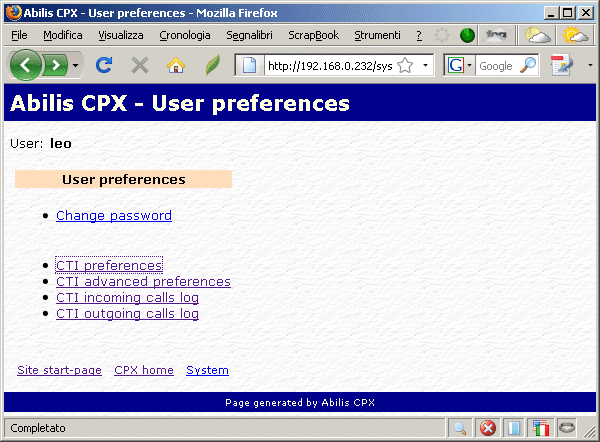
Figure: CTI preferences
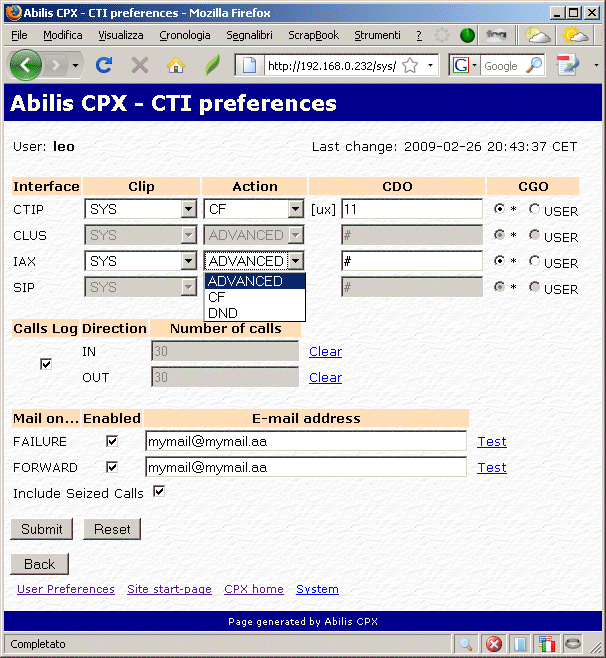
Figure: Advance CTI preferences

Figure: Incoming call log

Figure: Outgoing call log
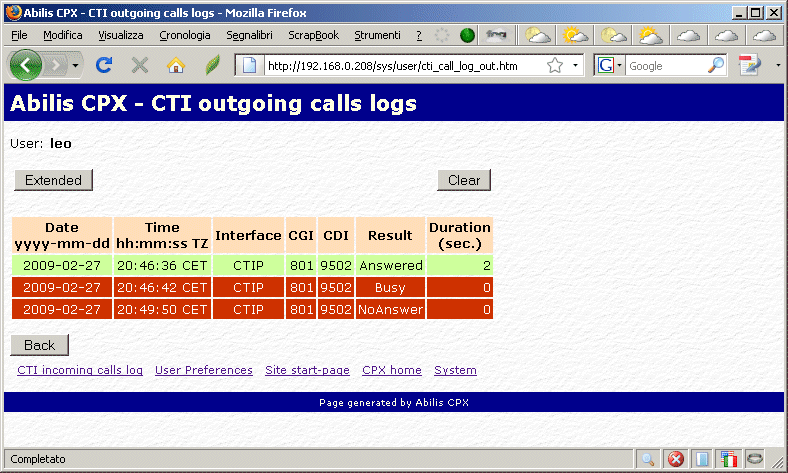
Here is an example of mail notification:
Figure: Mail notification on busy

The CF/DND can also be enabled via telephone keys by invoking a supplementary service.
Supplementary services are invoked by dialling a number that starts with
*, e.g.*0for a call pickup. Below please find the updated list of all supplementary services.Table: Supplementary service keycodes
Code Service *0 Picks up a call which is alerting, if allowed by configured permissions. *1<num> Picks up a call which is alerting on CTIP whose NUM is <num>, if allowed by configured permissions. *50 Enable ADVANCED CF/DND of the user which are set as ENABLED but NOT USED. *51 Disable ADVANCED CF/DND of the user which are set as ENABLED and IN USE. *52 Enable ADVANCED CF/DND of groups which are set as ENABLED but NOT USED. *53 Disable ADVANCED CF/DND of groups which are set as ENABLED and IN USE. *55** Enable do-not-disturb. *56** Enable do-not-disturb. *55*<num>* Set an unconditional call forwarding to <num>, using as calling number the own one. *56*<num>* Set an unconditional call forwarding to <num>, using as calling number the one of the incoming call. *57 Disable the user unconditional CF/DND, those enabled with *55* and *56*. *59 Disable all user unconditional CF/DND, those enabled with *50*, *55*, *56*. *60*<num> Make a call to <num> hiding the calling number. *61*<num> Make a call to <num> presenting the calling number. *62 Hide calling number by default. *63 Present calling number by default. *64 Restore the system setting for calling number presentation. -
-
Additional Debug Log events:
- E-SupEscaped
-
When CTIP/SIP/IAX user has supplementary services enabled, and he enters ** as first digit of the called number, he bypasses the Abilis CPX SS services and any further digit, including *, is managed directly as called number.
- E-CallForward
-
It indicates that a call forward has been executed according to user preferences or advanced preferences.
- E-DoNotDisturb
-
It indicates that a call has been refused due to a do-not-disturb configured in user preferences or advanced preferences.
-
Added new internal location F0. This cause is converted to 80 (location USER), in contrary to location FF which is still converted to 81 (LPN - Local Private Network).
-
Added the support of the Supplementary Services escape sequence.
If user wants to put an
*in the called number and he has supplementary services active, he must precede it with addition two *, e.g:In case that SS:YES *0 -> triggers supplementary service ***0 -> escapes supplementary services and puts *0 in the called number
-
Added display of IP resource IPADD and MASK on the MFIDE panel.
-
Added AC RELOAD and AC TEST messages on LCD during system initialization phase.
-
Changed maximal tracer buffer size from 8 Mb to 256 MBytes. Default value is still 8 Mbytes.
-
Changed the HTTP login cookie timeout, now the user can choose between the system default timeout (
COOKIE-TOUT:parameter in HTTP resource), or expiration on browser close, or never expiry. -
Changed in SIP and IAX the CHAN-FREQ: range.
Now it is possible to configure value 20 too. The behaviour is exactly the same as configuring value 30 (20 msec coders uses 20 and 30 msec coders uses 30), but it is less confusing for the user.
-
Optimized RTP management for CHAN-FREQ >=40. Now the CPU consumption is sensibly lower.
Bug fixes
-
Version 6.3.0 includes all the bug fixes and enhancements there were made between the 6.2.0 and 6.2.4.
Known bugs
-
Supplementary services keycodes
*62,*63and*64are not supported.